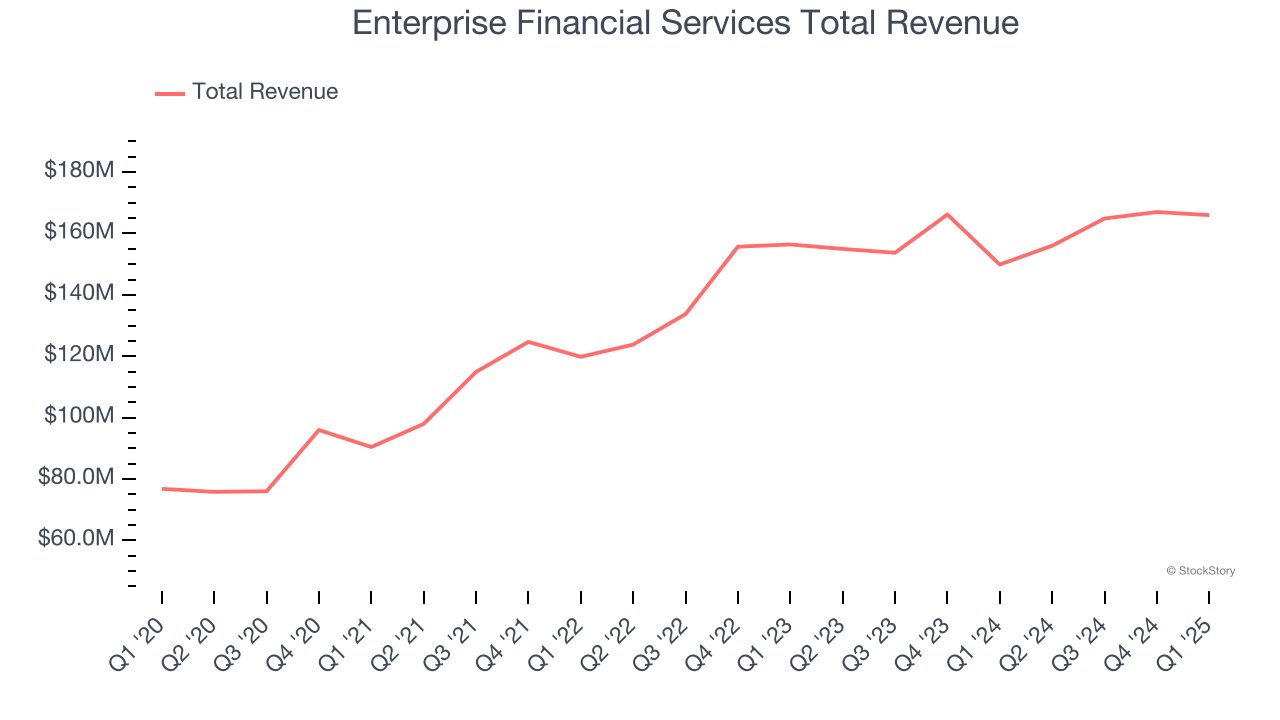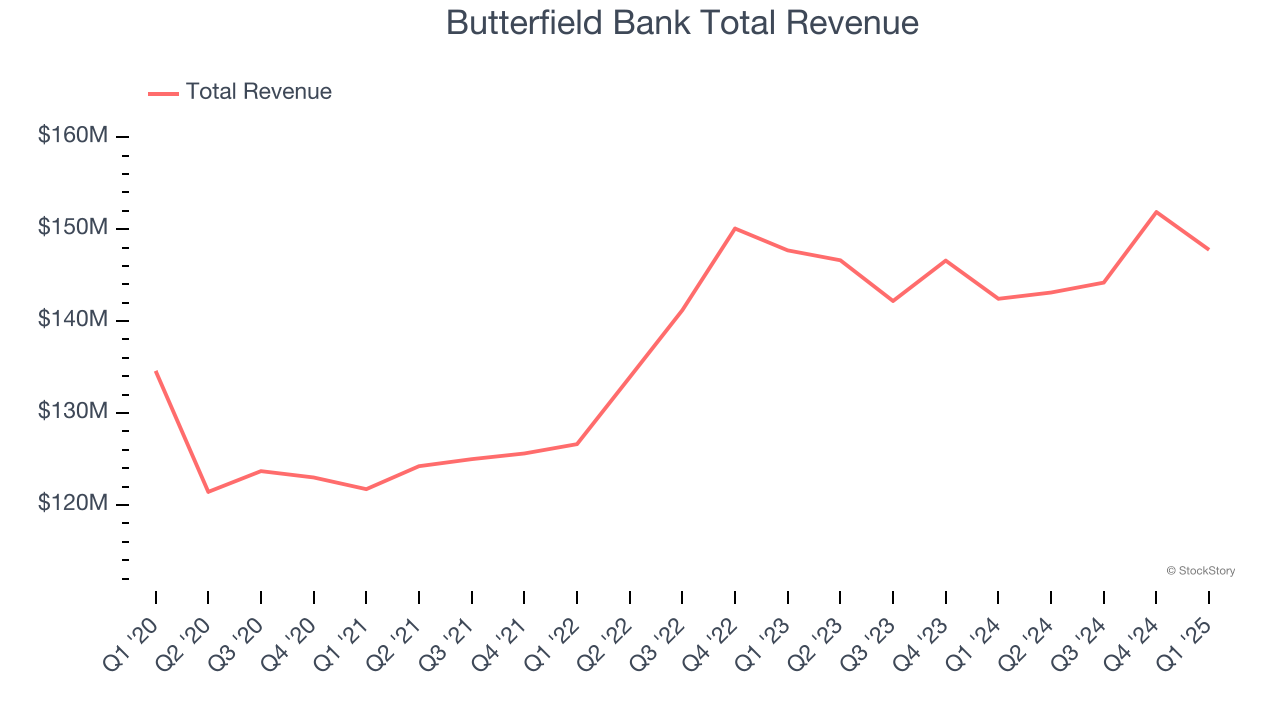
As the Q1 earnings season wraps, let’s dig into this quarter’s best and worst performers in the regional banks industry, including Enterprise Financial Services (NASDAQ:EFSC) and its peers.
Regional banks, financial institutions operating within specific geographic areas, serve as intermediaries between local depositors and borrowers. They benefit from rising interest rates that improve net interest margins (the difference between loan yields and deposit costs), digital transformation reducing operational expenses, and local economic growth driving loan demand. However, these banks face headwinds from fintech competition, deposit outflows to higher-yielding alternatives, credit deterioration (increasing loan defaults) during economic slowdowns, and regulatory compliance costs. Recent concerns about regional bank stability following high-profile failures and significant commercial real estate exposure present additional challenges.
The 105 regional banks stocks we track reported a mixed Q1. As a group, revenues missed analysts’ consensus estimates by 1.6%.
In light of this news, share prices of the companies have held steady as they are up 4.5% on average since the latest earnings results.
Enterprise Financial Services (NASDAQ:EFSC)
Starting as a single bank in Missouri in 1988 and expanding through strategic growth, Enterprise Financial Services (NASDAQ:EFSC) is a financial holding company that offers banking, lending, and wealth management services to businesses and individuals across seven states.
Enterprise Financial Services reported revenues of $166 million, up 10.8% year on year. This print exceeded analysts’ expectations by 3.1%. Overall, it was a strong quarter for the company with a solid beat of analysts’ EPS estimates and a narrow beat of analysts’ net interest income estimates.

The market was likely pricing in the results, and the stock is flat since reporting. It currently trades at $54.20.
Is now the time to buy Enterprise Financial Services? Access our full analysis of the earnings results here, it’s free.
Best Q1: Butterfield Bank (NYSE:NTB)
Founded in 1784 as one of the oldest banks in the Western Hemisphere, Butterfield Bank (NYSE:NTB) provides banking, wealth management, and trust services to individuals and businesses in select offshore financial centers including Bermuda, Cayman Islands, and the Channel Islands.
Butterfield Bank reported revenues of $147.8 million, up 3.7% year on year, outperforming analysts’ expectations by 4.4%. The business had a stunning quarter with an impressive beat of analysts’ net interest income estimates and a solid beat of analysts’ EPS estimates.

The market seems content with the results as the stock is up 3.2% since reporting. It currently trades at $43.76.
Is now the time to buy Butterfield Bank? Access our full analysis of the earnings results here, it’s free.
Weakest Q1: Triumph Financial (NASDAQ:TFIN)
Originally focused on traditional banking before pivoting to serve the transportation sector, Triumph Financial (NASDAQ:TFIN) provides specialized financial services to the trucking industry, including payments processing, factoring, banking, and data intelligence solutions.
Triumph Financial reported revenues of $100.8 million, flat year on year, falling short of analysts’ expectations by 3.8%. It was a disappointing quarter as it posted a significant miss of analysts’ tangible book value per share and net interest income estimates.
Interestingly, the stock is up 11.6% since the results and currently trades at $55.62.
Read our full analysis of Triumph Financial’s results here.
Wintrust Financial (NASDAQ:WTFC)
Founded in 1991 as a community-focused alternative to big banks in the Chicago area, Wintrust Financial (NASDAQGS:WTFC) operates community banks in the Chicago area and provides specialty finance services including insurance premium financing and wealth management.
Wintrust Financial reported revenues of $643.1 million, up 6.3% year on year. This print met analysts’ expectations. Aside from that, it was a mixed quarter as it also logged a decent beat of analysts’ EPS estimates but tangible book value per share in line with analysts’ estimates.
The stock is up 20.5% since reporting and currently trades at $122.43.
Read our full, actionable report on Wintrust Financial here, it’s free.
National Bank Holdings (NYSE:NBHC)
Operating under familiar local brands like Community Banks of Colorado, Bank Midwest, and Bank of Jackson Hole, National Bank Holdings (NYSE:NBHC) operates regional banks across Colorado, Kansas, Missouri, Wyoming, Texas, and other western states, offering commercial, business, and consumer banking services.
National Bank Holdings reported revenues of $102.1 million, flat year on year. This number lagged analysts' expectations by 2.8%. Overall, it was a disappointing quarter as it also produced a significant miss of analysts’ net interest income and EPS estimates.
The stock is flat since reporting and currently trades at $36.80.
Read our full, actionable report on National Bank Holdings here, it’s free.
Market Update
Thanks to the Fed’s rate hikes in 2022 and 2023, inflation has been on a steady path downward, easing back toward that 2% sweet spot. Fortunately (miraculously to some), all this tightening didn’t send the economy tumbling into a recession, so here we are, cautiously celebrating a soft landing. The cherry on top? Recent rate cuts (half a point in September 2024, a quarter in November) have propped up markets, especially after Trump’s November win lit a fire under major indices and sent them to all-time highs. However, there’s still plenty to ponder — tariffs, corporate tax cuts, and what 2025 might hold for the economy.
Want to invest in winners with rock-solid fundamentals? Check out our Strong Momentum Stocks and add them to your watchlist. These companies are poised for growth regardless of the political or macroeconomic climate.
